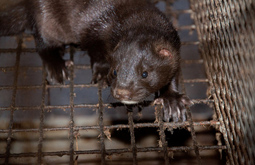American minks in farms
On farms, minks are held in standard-sized cages of 0,26 m² and heights of 30 to 45 cm. The constriction of the cages makes it impossible for the minks to move in line with their requirements. In addition to this, the wire floors of the cages lead to injuries and deformations of the paws. The cages are equipped with small wooden nesting boxes with roofs, usually also made out of wire, that do not offer the animals the security of their natural, shady habitat.
Moreover, the unstructured cages do not offer the minks the possibility to climb or to discover. The fact that the minks are not provided access to water is particularly torturous for these animals that require the proximity of water by nature. The missing of this natural component is massive animal torture. Studies have shown that minks often take on major physical exertion in order to be able to swim. Disregard of this and other natural needs make the minks react stereotypically, for instance by walking back and forth incessantly in their cages or by attempting to dig holes in the cage floors.
Female animals used for breeding do not have the possibility to withdraw from their young, which is a cause of substantial stress. At 7 weeks of age, the young are separated from the mother animal. This does not correspond to the animal’s biological behavior and leads to behavioral disturbances, e.g. the chewing off of their own fur and self-mutilation, i.e. the minks biting off their own tails. Following separation from the mother animals, the minks are held individually or in couples. This does not comply with their natural behavior either, because minks never live in pairs in nature. In addition, on fur farms, hundreds of cages are lined up one next to another. The animals live practically on top of one another, without the possibility to avoid physical, visual, olfactory or acoustic contact. For minks that are loners, this means tremendous stress that is expressed by aggressive behavior towards other minks. This massive stress leads to self-mutilation, mutual injuring and even killing.
As for all wild animals, contact with human beings means significant stress. The minks are regularly removed from their cages for breeding, for their fur to be measured, for medication, for the changing of cages, etc. To this the minks react with extreme fear.
No access to water

CAUTION!
The following two films demonstrate hard facts and therefore may not be suited for everyone, in particular not the sensitive!
A mink farm in Ireland
The gazing of minks
Additional information
-
The «Humane Society of the United States» and its Fur free campaign
The Canadian environmental protection organization «Global Action Network» and its extensive anti-fur campaign.
